#silk cotton fabric
Explore tagged Tumblr posts
Text
How to Sew a Midi Dress with Side Pockets and Corset Back: A DIY Guide
In this post you learn how to sew this stunning midi dress using my free printable pattern. Do you want to create your own style and express your personality through fashion? If so, you’ll love this DIY project that teaches you how to sew a midi dress with side pockets and a corset back. This dress is chic, comfortable, and versatile, making it suitable for any occasion. Plus, you can customize…

View On WordPress
#corset back#diy fashion#dress pattern#midi dress#sewing#sewing tutorial#side pockets#silk cotton fabric#sleeveless dress
1 note
·
View note
Photo

Kora Silk Cotton | Multicolor Pochampally Silk Cotton Sarees | Pure Silk Cotton Sarees - Sundari Silks
This Kora Pochampally Silk Cotton Saree in multicolor, features allover design in the body and has a bright orange border with zari stripes. The saree has a multicolor pallu with allover design and comes with a bright orange blouse.
Shop from: www.sundarisilks.com/collections/koorainadu-silk-cotton
Visit our website: www.sundarisilks.com/
#sundarisilks#kora silk cotton sarees#multicolor silk cotton sarees#pure silk cotton sarees#silk cotton fabric#light weight silk cotton sarees#silk cotton sarees online#authentic silk cotton sarees#silk cotton handicrafts#handloom silk cotton sarees#shop for silk cotton sarees#sundarisilks silk cotton sarees
0 notes
Text
I'm a stiff breeze away from custom ordering my own organic fabrics and making my own damn clothes and im not joking
#if anybody knows where to get decent quality organic fabrics like silks or pima cotton or something hmu#i hate the fashion industry so much its unreal im not buying plastic bullshit made to fall apart that feels awful#not even to mention the unethical labor practices#i need to make my own weirdo dresses or ill doomspiral#fashion#casinos whining hour#just yakkin
456 notes
·
View notes
Text

okay his outfit has really been bothering me for absolutely ages so here. bastard man.
#warhammer rogue trader#pasqal haneumann#pasqal rogue trader#when i say its been bothering me. know i am too well informed about fabrics and sewing#so i need it to make sense. it cannot be one layer it just doesnt make sense#and [youre seeing my madness now] it SEVERELY bothers me when tech priests dont wear canvas or leather#i am sorry they are NOT going around in lightweight cotton. and have you seen how much oil stains they do not wear velvet or silk either#most insane hc ever: i dont think theyve reinvented polyester yet in 40k. i just cant see it#its like any other oddly specific fabric lost through time#archaeotech yet to be figured out..........#anyway pasqal wears thick leather abel wears stiff canvas thats worn out through the years to be softer
40 notes
·
View notes
Text
Muslin: The fabric that was all the rage in Napoleonic Europe
Muslin fabric was a favorite of the Empress Josephine, pictured here wearing a dress made of the fabric, in a portrait by François Gérard:
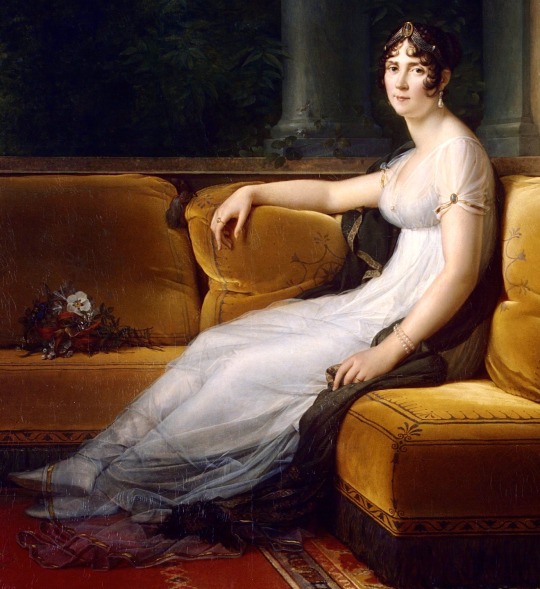
It was extremely sheer and it had the effect of making the wearer appear almost nude, especially in certain lightings.

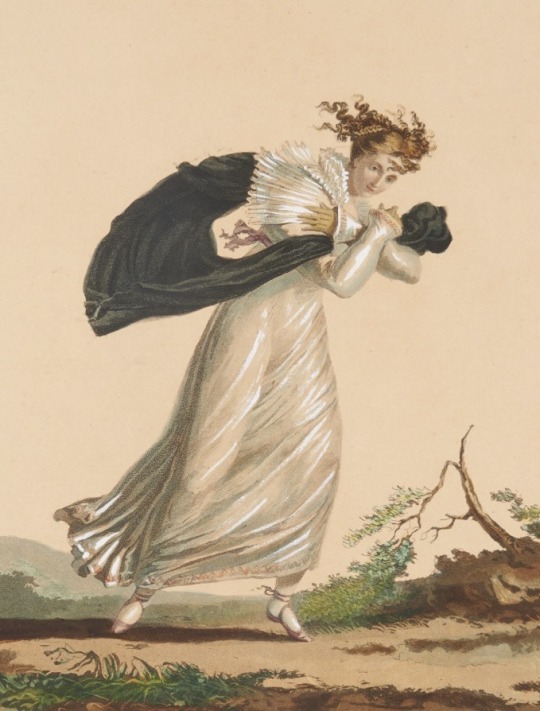
Vent derrière by Philibert-Louis Debucourt, 1812
This is a portrait of Pauline Bonaparte, Napoleon’s sister, wearing the fabric. As you can see, the entire chest area is completely exposed.

It was most commonly worn by elite Parisian women and other women in the upper social strata of European society and less so by peasants, who couldn’t always afford it and also tended to favor modesty.

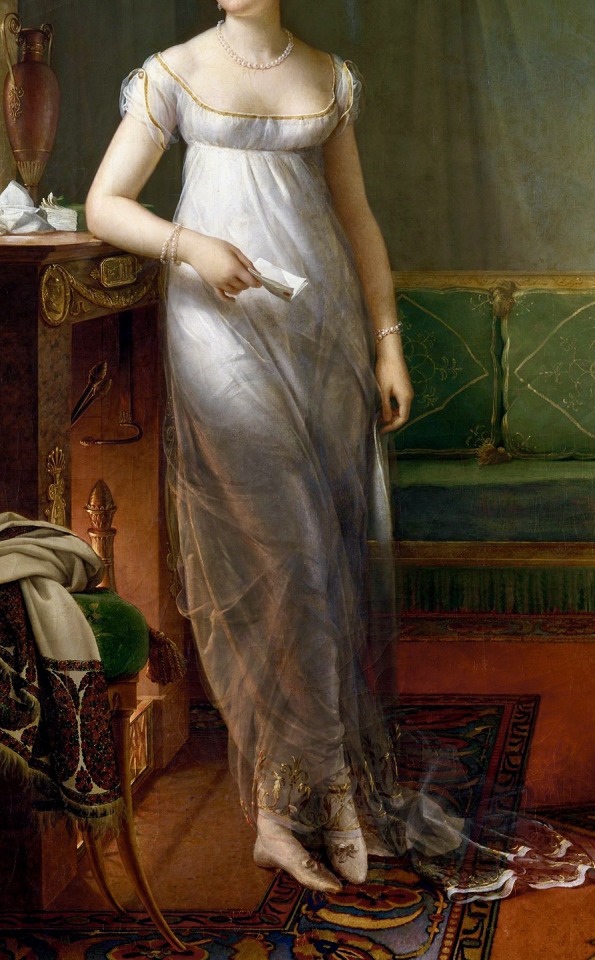
Above (left-right): Pauline Bonaparte, Madame Charles Maurice de Talleyrand Périgord
To call the fabric popular would be an understatement. During the 20th century, there was the “little black dress.” In the early 19th century, it might as well have been called the “little white dress.”
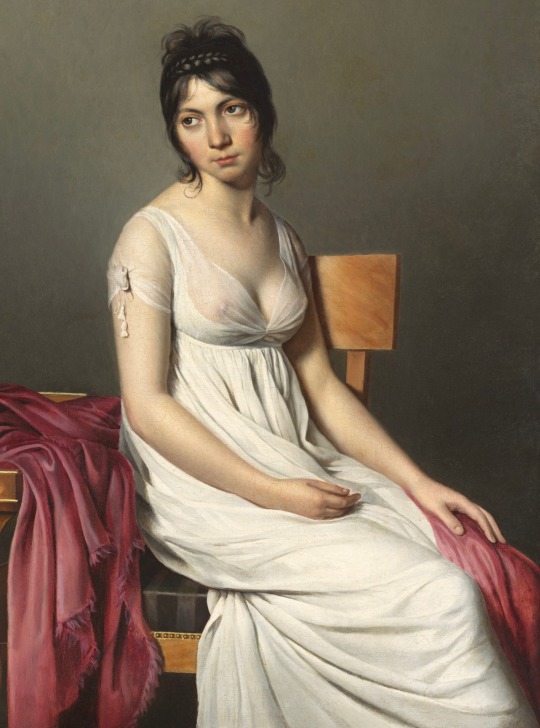
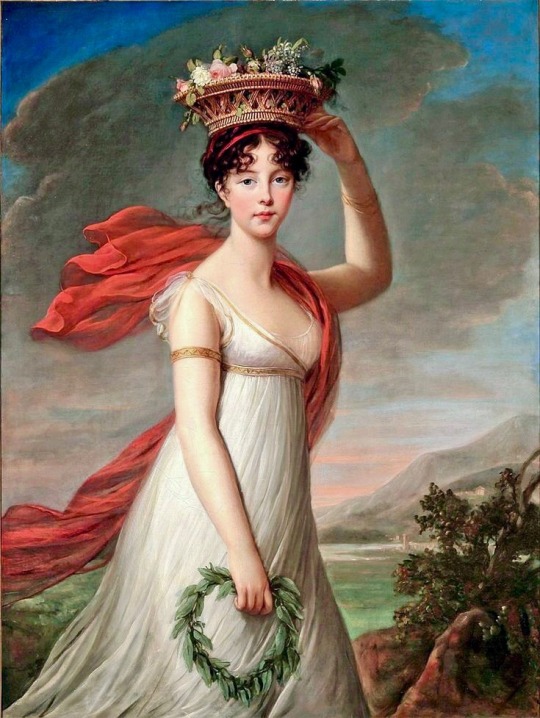
Artist (left-right): Circle of Jacques Louis David, Élisabeth Louise Vigée Le Brun
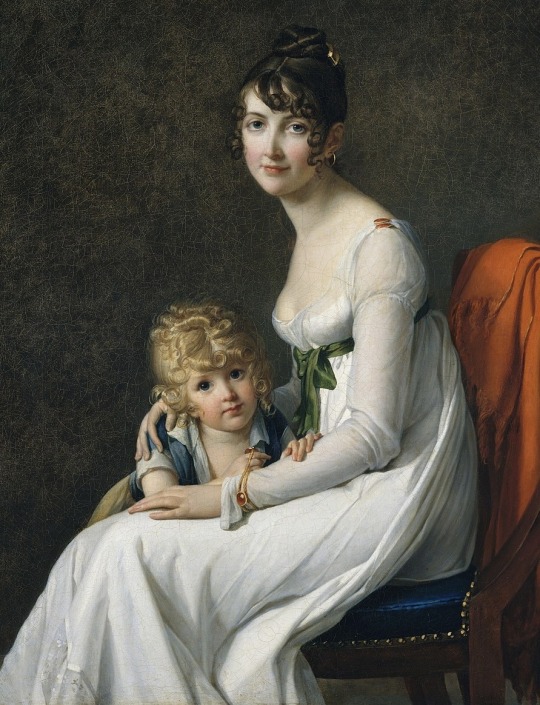

Artist (left-right): Marie-Guillemine Benoist, Jean-Bernard Duvivier
Muslin fabric was made of cotton and imported to Europe from India. This radical change of fashion had begun in the 18th century and caused the French silk industry to lag. Napoleon, in an effort to improve domestic industry, focused his attention on reviving the French silk business. Court dresses in the First French Empire came to be dominated by shiny white silk. This trend continued into the rest of the 19th century and muslin fell out of favor, replaced by silk, satin and tulle.
Sources:
#fashion history#empire style#napoleonic era#empire period#first French empire#napoleonic fashion#empire#history of fashion#text#article#19th century#18th century#muslin#fabric#cotton#silk#Lyon#France#French#French empire#premier empire#French fashion#fashion industry#history#textiles#art#French art#women’s art#female artist#napoleonic
444 notes
·
View notes
Text
Today’s mood:
Overwhelmed by the scope of the task that is replacing my historical wardrobe and fabric stash. Just in terms of both cost, and how limited the availability of silk and wool at my local fabric stores has become even compared to when I made some of the gowns I lost, and bought some of the fabric
#personal#fireblogging#I keep thinking of things. I still had some more of that Garnet colored silk that I made a ball gown out of for my birthday#I was going to make a day bodice to go with the skirt#I had some beautiful sage green ribbed cotton that I had started a skirt out of and was going to make a matching bodice for that too#Plus they don’t make the olive green silk chiffon I used for the overlay on one of my Regency ballgowns#anymore#and even the things I can rebuy are so expensive… It’s just making me feel rather despairing at the moment#(I don’t do plastic fabrics because I sweat too much in them)
137 notes
·
View notes
Text
Have I ranted to you lot about the person who was looking for donations of "cotton" (fabric)?
I'm like sure, I have lots of cotton fabric. What kind are you looking for? I have jersey, I have quilting cotton, etc.
Turns out that she didn't actually know much about fabric (good for her for taking on sewing projects like this anyhow), and as far as I can tell meant quilting cotton specifically. To quote: "I'm honestly not sure what you mean about woven - cotton fabrics are woven, I thought..."
And like, I get it. It's hard to learn that sort of thing. I've read multiple guides on different fabric types and still can't recognise most of them. And the fact that I'm embarrassed that I can't recognise what counts as a shirting-weight fabric, or that a fabric is chambray should help me have compassion for someone who didn't have enough, frankly rather esoteric, knowledge of fabric types to know what they didn't know.
But cotton. Have you never read the tag on a t-shirt and seen what percentage cotton it is? Of all the fibre/weave/fabric type mix ups, cotton?
#For example#we had a Reach for the Top question about what linen was from#I buzzed in faster than my teammate#which was good#because he would have said cotton#because he legit didn't know what linen was#and was thinking of household linens#(he may have known about linen but not well enough to think of it)#and I don't complain about flannel vs flannette#especially since one of those you can buy in stores#and the other is a specialty fabric#and I'm sure there's stores that sell it#but I wouldn't know where#people thinking that silk means silk satin#that sort of thing#but cotton is an every day fibre!#how do you not know that?
8 notes
·
View notes
Text
I don't think that ppl who insist plus sized clothing should be more expensive because it's """so much more fabric""" have ever been to a fabric store in their life
#the waist size difference between a xxs and 6xl is about a yard. a yard of cotton at fucking joanne fabrics costs like 5 dollars#I think that multimillion dollar companies can affort to lose like 7 dollars on a pair of pants#also most of the cost of clothes unless its like 100% cashmere or silk is for labor not materials#which is why clothes made in places that can pay their 'employees' 6 cents an hour sell cheaper clothes#of course materials is part of it but huge corporations usually do not have to worry about cost of materials#and also go fuck yourself#ghost posts#text
13 notes
·
View notes
Note
For the worship thing - remember that psychopomp costume you made? I have no words to describe the entity/occurance you fall under but that is your head priest garment

You're so fucking right my guy!!! Death, decay, the passage of time/life itself and all things forgotten and faceless are an enormous part of me and my belief (hence my inclination towards fungi too) and tbh making this costume was a love letter to all of that! ❤️
#I NEED to take this costume out again#The ionic chiton (which unfortunately you can't see properly) is made of silk with handmade woolen ball buttons atop the#In place of fibulae#The himation is a cotton chiffon with an interwoven pattern#That looks EXACTLY like livor mortis marbling!! Like SPOT ON#Unfortunately the fabric was too short so I had to make the head veil SEPARATE from the himation and I'm still mad about it#And I still wish I made the stephane / tiara slightly differently and in more detail but it fits and I'm lazy so that's how it stays#Ah psychopompós my beloved#Responses#Thank you Luc!! You are so correct
15 notes
·
View notes
Text


Is this waistband going to be almost completely hidden by the bodice? Yes! Am I doing a bunch of embroidery on it anyway? Also yes.
#all the colors are slightly *off* from each other but that’s okay! i mostly can’t stand the ide of using cotton thread over my silk fabric#so im using a slightly too blue silk#but i may try and dunk the thread in some yellow dye?#pancake makes the glass gown#pancake makes the frostflower skirt
5 notes
·
View notes
Text
youtube
Today we’re making the most of poppy season to create some beautiful colours on silk and cotton. With some extra wild flowers thrown in for good measure.
The pioneer play kit from Lovevery
https://lovevery.eu/products/the-play...
BillyNou shop on https://www.billynou.com/
How to BUNDLE DYE with POPPIES
How do you dye fabric with flowers?
How do you natural dye?
Which flowers and vegetables make the best dye?
How do you dye fabric naturally?
#BillyNou#solarpunk#bundle dye#natural dye#how to#how to dye#how to bundle dye#diy#do it yourself#poppies#flowers#silk fabric#cotton fabric#fabric#Youtube
4 notes
·
View notes
Text
#lsfab #tonyfab #curtain #sofa #pillow #softbed #wall #softbag #cushion #clothing #tablecloth #hotelproject #modelroom #designer #indoorsoft-fitting #customizedservice #finishedcurtain #textiledesign #fabric #cotton #silk #velvet #suede #design #upholster #minottifabrics
2 notes
·
View notes
Text
I feel like goths are going to ramble about the whole whimsigoth thing sooner or later so I'm gonna say it now: it's 10 times prettier than any trad goth outfit I've ever seen irl, no amount of festival kitch and punk rave can beat this shit (Although I'd like a vampire spinoff, whimsivamp or something)
#Obv anyone can wear what they want <3#I'm just a big fabric elitist and sorry but most goths are made of polyester it's UGLY ok#and whimsigoth seems to have a lot of natural fabrics#be it cotton linen silk wool#whatever. Don't get vegan into this#there are plenty of natural vegan wool/leather substitutes#BUT YALL JUST REFUSE TO WEAR IT AND WEAR KILLSTAR PLASTIC#so good for the planet yea right
4 notes
·
View notes
Text
Why handloom fabric will never go out of Style
With increased awareness of the fashion industry's negative impact on the environment, people have started to show a massive desire for handmade and hand-loomed items.
They realize the value and specialty handmade pieces bring to the table and in one's life. There is something special about handloom fabrics, it not only provides exclusive textiles, but the mastery of handloom fabrics is unique, authentic, and artistic.
The people behind creating this fabric have put significant effort, love, and passion into making these beautiful textiles.
So ever wondered what really are handloom fabrics?
What are handloom fabrics?
So, before learning about handloom fabrics, let us know what a loom is first.
A loom is a machine operated to weave cloth and tapestry. The primary purpose of any loom is to hold the warp threads under tension to stimulate the weft threads' interweaving to create a textile.

Further, handloom fabrics are handwoven fabrics created on this weaving machine.
To create a handloom fabric, the weaver starts the process by interlacing a set of vertical threads(the warp) with a bunch of horizontal threads(the weft).
Then the loom holds the warp threads under tension to facilitate the interweaving of the weft threads over and above the warp using a weaving shuttle. Finally, the weaver repeats the interweaving process until the handloom fabric is created.
Handloom weaving requires the utmost patience, artistry, technical skills, and physical strength.
Creating handloom fabrics is not just about protecting nature but also about love. The weaver's passionate about what they are making, they put their heart and soul into creating this textile. They select the yarn, pattern, color, texture, and accurate technique to create the suitable fabric, and it's reflected on the material.

Handloom fabrics don't feature just one type of fabric, instead, it comes in a variety of rich colors, patterns, and designs.
The reason handloom fabrics have wide varieties is that it's directly linked to the culture of each community. They have passed on their designs from generation to and formed an identity of their own.
Advantages of handloom fabrics:-
Originality and Uniqueness
The most significant advantage of handloom fabric is that no two hand-loomed materials are the same. Each fabric exhibits unique craftsmanship.
Variousness
As the handloom allows the weavers to explore their creativity in creating beautiful textiles, they explore new ideas and make some extravagant designs and patterns.
Quality
The fibers used to create handloom fabrics are high-quality natural fibers like cotton, linen, silk, and wool; these are environmentally friendly and long-lasting fabrics.
Good for the skin
The handlooms use natural fibers that protect the skin and don't harm it. In addition, it feels good on the skin, unlike synthetic fiber.
Skill preservation and source of livelihood
Since ancient times handloom has proved to be a great source of livelihood across rural India. Even today, the handloom community has preserved its heritage and employs numerous people.
Types of Handloom Fabrics:
Khadi: Khadi, the hand-spun fabric, referred to as the hope of our environment is a fabric known for our nation's freedom struggle, representing the love for our country and its people.
It is made by using natural fiber and is woven so that this fabric will keep the body cool during summer and warm during winter.
Kala Cotton: Kala Cotton is an organic woven textile that allows for sustainable living, as the production is purely ecological with no pesticides and synthetic fertilizers used. It is durable, strong, and stretchable, and it takes dye brilliantly
Tussar Silk: Tussar Silk is the strongest natural textile in the world. The fabric is highly breathable with high moisture-wicking abilities. Despite its immense tensile strength, its softness has made it a hotly desired commodity throughout history.
Mulberry: Mulberry silk is the highest quality silk that is smooth to the touch and has a glossy look. It is one of the oldest types of silk fabric that comes from moth cocoons.
What makes mulberry silk different from other silks is the uniform quality of the fibers. The diameter, color, and texture of a strand of mulberry silk are the same from one cocoon to another.
Muga Silk: Muga Silk follows the path of Ahimsa, meaning not causing harm to other living things. Therefore, this silk is produced without killing the creatures that crafted it. Instead, this silk is a step towards appreciating and supporting the beautiful soul and nature that created it.
Banana: Banana fabric is developed from the outer lining of banana peels. This fabric is one of the most luxurious fabrics. It is soft like silk on the inside and hard like cotton on the outside, making it one of the best fabrics to create comfortable, long-lasting, quality garments, decors, and accessories.
Organic Cotton: Organic cotton comes with various benefits for our environment and our people. For example, this fabric doesn't retain chemicals from its garments, due to which it reduces exposure to allergens and dermatological issues.
The use of organic cotton benefits the farmer as they are exposed to fewer chemicals.
There are so many benefits and types of handloom fabrics that they can never get out of style.
Bulk Organic Handloom Fabric Supplier and Manufacturer:
Suvetah is one of the leading bulk organic handloom fabric suppliers and manufacturers in India.
Suvetah is GOTS certified sustainable fabric manufacturer in Organic Cotton, Linen, and Hemp Fabrics.
We are also a manufacturer of other fabrics like Denim, Ahimsa Silk Fabric, Ethical Recycled Cotton Fabric, Banana Fabric, Orange Fabric, Bamboo Fabric, Rose Fabric, Khadi Fabric, etc.
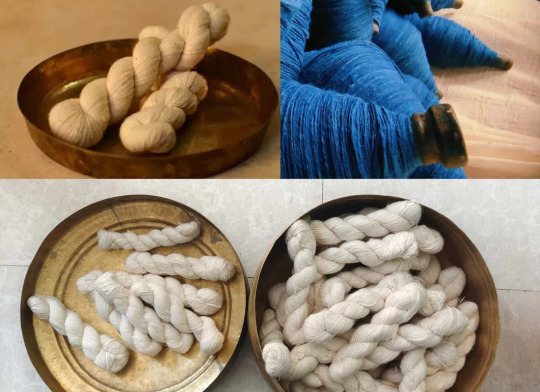
#muga silk#muga silk sarees#mulberry silk#silk saree#plain saree in silk#fabrics cottonplain saree in silk#dyed fabrics#cottony fabric#crepe fabrics#fabrics cotton#fabrics printed
2 notes
·
View notes
Text
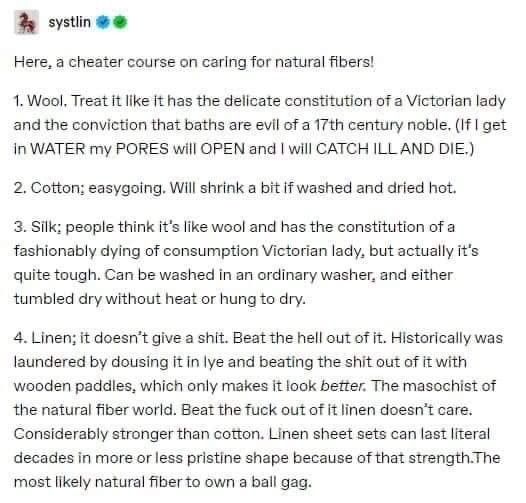
I’m allergic to wool but I wash and dry all my fabrics. Before I sew. Because I’m Evile and if I can’t throw it in the washer and dryer, I don’t need it.
2 notes
·
View notes
Text
Barely restraining myself from purchasing fabric
#i don’t need her#but I NEED her if ya feel#found a better fabric for my bf’s ren faire cape (not that he even remembers that he asked for it 🙄)#and some lovely fabrics to go with some outfits I’m making#I can’t help it#I see linen and I go absolutely feral#she’s so lovely#and they have a silk tulle I’m DYING to try out#AND a cotton velveteen that would be perf for a mockup of my wedding jacket#okay I’m definitely bot going to be able to restrain myself fully lol#:)#the fiend speaks#sewing#fabric#fabric shopping#please I want to find my people
3 notes
·
View notes